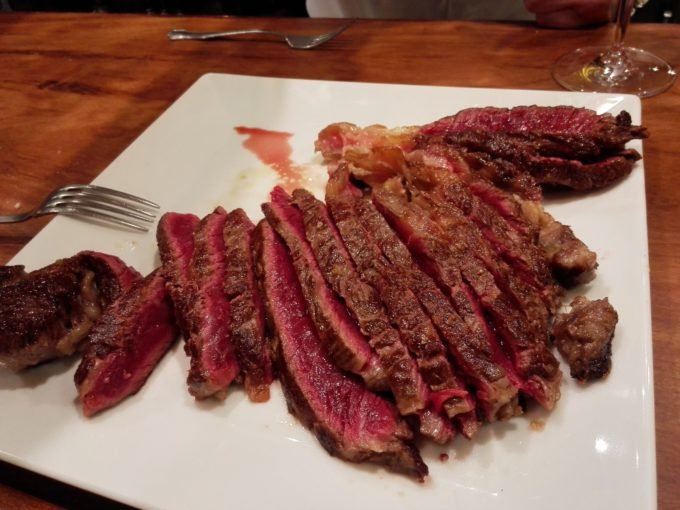
How to Survive a 20‑Hour Basque Breakfast

How to Survive a 20‑Hour Basque Breakfast
T-Bone Breakfast in Bilbao
Breakfast had started 20 hours earlier, during a lunch in Baserri Maitea, a rustic restaurant 42 kilometers (26 miles) from the Guggenheim Museum in Bilbao. Below the hundreds of wooden beams inside Baserri Maitea, Juan Antonio Zaldua—once the strapping goalie for Athletic de Bilbao—filled our table with ingredients touched by fire and the expert hand of the grill master: chunks of hake throat bathed in pil pil, an emulsion of olive oil and the fish’s natural gelatin; sole that had surfed the famous waves of Mundaka hours earlier; and a sirloin from an 8-year-old German cow aged for 18 days.
The blame for the breakfast plan belongs largely to the giant steak and its light, seductive coat of smoke. And, of course, to the bottles of Señorio de Otxaran, the effervescent txakolí, sacred wine of the Basques. Mikel Zeberio, restaurateur, storyteller, and a man of a thousand other trades, one of the Basque men who knows about quality ingredients, proposed a challenge: “Who dares to eat another steak tomorrow at 7:30 in the morning? Come with me to the market and afterwards we’ll head to the txoko,” he said, referring to the famous Basque gastronomic societies, the types where men gather to eat and drink the day away.
We have more than enough time in our lives to start the day with a croissant—why not a steak? Three bottles of txakolí between three people doesn’t do much for one’s judgment, but at least we managed to push the starting hour back to 9:30. We also changed the meeting place to Mugi, a wine and pintxos bar, run by Juanma Díez, a friend of Mikel and a man of character. As for the steak itself, after we paid the bill for our meal at Maitea, Zaldua brought out at a vacuum-packed gift and dropped it on the table: a three-pound cut of first-rate ribeye. Mikel said we should cook it in a pan instead of on a grill. If Zaldua had an opinion about this lesser treatment of a prized piece of protein, he kept it to himself.
The next morning when we arrived at Mugi, the blinds were still only half-drawn, the universal sign for “Intruders Keep Out”. Not even a coffee machine was stirring. We crouched down to peek in and there was Juanma, breaking up ice on the other side of the bar with Mikel close by. Back and forth Juanma and Mikel traded barbs like only the best of friends can do. (The loving insult is the currency of true comrades.)
[Read: What to know before you go to Basque Country]
We thought that the steak would burn in Mikel’s hands, but he had a few surprises up his sleeve. He started us off with an appetizer, which he placed on the counter next to an iced bottle of white Ana de Altún. It was still cafe con leche time, the hour of yawns and donuts, and here we were, about to stick a fork into an extraordinary piece of tuna belly, one of the best I’ve ever tried. After that came a huge weeping omelet laced with chunks of pickled quail. “So modern!”, Mikel said with a flash of irony. This old-school omelet was his dad’s favorite, a man who used to work at the Palace in Madrid. The jokes and bottles kept coming, one on top of the next, topped off by a river of hard cider made by Mikel, the spirited conductor of this breakfast orchestra.
The moment of the steak finally arrived, enriched with sage council from the cook: It’s vital to temper the meat, he told us, to raise the internal temperature of the beef without actually cooking it by leaving it on the counter for a few hours. In a pinch, he said, a home cook could use the defrosting setting of the microwave. Had a traditional grill master walked into the room at that exact moment, he would have died on the spot from the blasphemy. But Mikel taught grilling classes at the Basque Culinary Center, which somehow validated the outlandish advice. He wasn’t into the typical flurry of coarse salt either, preferring the subtlety of a shower of Maldon crystals added only after cooking. After browning the surface of the steak in a pan with a puddle of olive oil, he served it sliced off the bone. The technique may have been controversial, but the results were not: the steak melted into our palates. Starting the day upside down clearly has its merits.
On our way back to the hotel for a rest (hoping it wasn’t eternal), Mikel had the idea of stopping in a little bodega called El Palas, where he ordered a round of pintxos: sliced baguette topped with chunks of albacore, roasted red pepper, pickled peppers, and anchovy. The classic dessert. In two hours we were slated to have lunch at Mina, where chef Álvarro Garrido would feed us sweetbreads with pumpkin and another eight courses. The only way to keep my stomach from shutting down entirely was to keep it thinking that breakfast never ended.